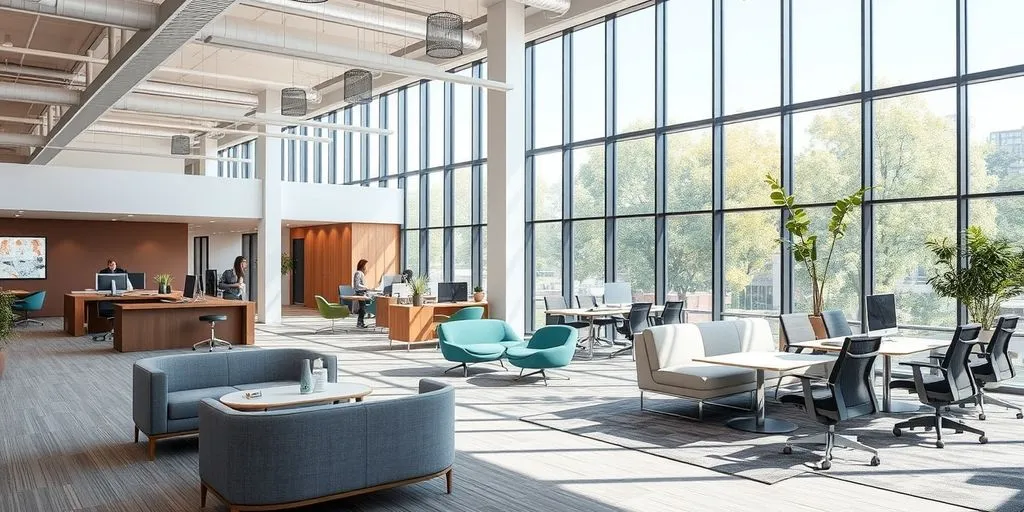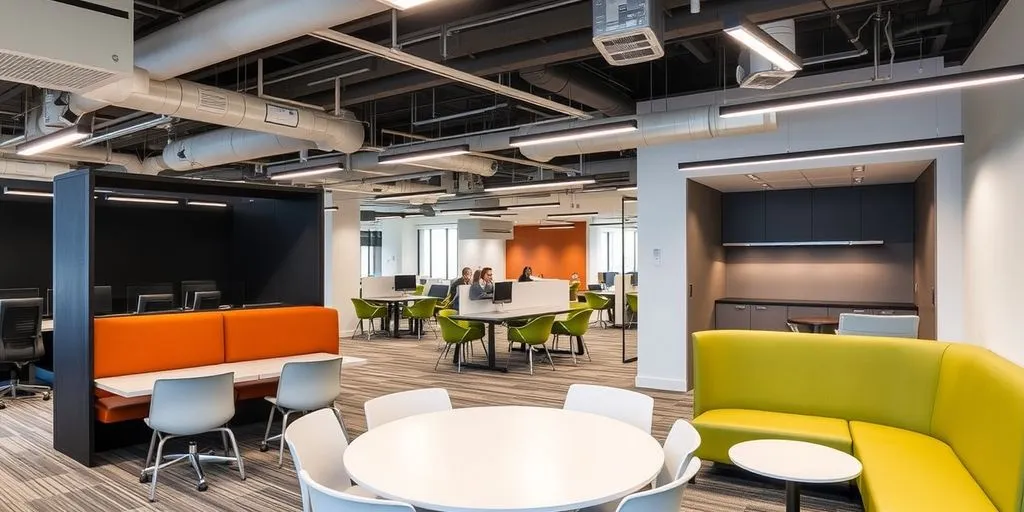September 17, 2024

The rise of flexible workspace solutions is reshaping how businesses operate. With changing work habits and technological advancements, more companies are moving away from traditional office setups. This shift is driven by the need for adaptability, cost efficiency, and enhanced employee satisfaction.
Flexible workspace solutions have come a long way from their humble beginnings. Initially, businesses were tied to long-term leases and rigid office setups. However, the need for more adaptable work environments led to the rise of flexible offices, allowing employees to choose from various work areas. This shift was driven by the desire for more freedom and efficiency in the workplace.
Several factors have contributed to the evolution of flexible workspaces. Changing work styles have played a significant role, with more employees seeking remote and hybrid work options. Additionally, cost optimisation has become crucial for businesses, making flexible workspaces an attractive alternative to traditional office leases. The ability to scale up or down as needed has also been a key driver, providing businesses with the agility to respond to market changes.
Technology has been a game-changer in the development of flexible workspaces. From virtual collaboration tools to cloud-based platforms, advancements in technology have made it easier for teams to communicate and collaborate, regardless of their location. This integration of technology has empowered businesses to embrace digital transformation and enhance the efficiency of their work environments.
The evolution towards more adaptive work environments is embodied by the flexible office, which allows employees to choose from various work areas.

Flexible workspaces help businesses save money in several ways. They reduce real estate costs by eliminating the need for long-term leases and large upfront investments. Companies can also save on operational costs like utilities, cleaning, and security by outsourcing these services to workspace providers. Additionally, flexible workspaces offer transparent pricing models, making it easier for businesses to budget and avoid unexpected expenses.
Flexible workspaces can significantly boost employee satisfaction. Employees who have the freedom to choose their work environment are often more engaged and happier. This flexibility can also enhance a company's appeal to top talent, making it easier to attract and retain skilled workers. Moreover, a supportive work environment can reduce employee turnover.
Flexible workspaces allow businesses to easily scale up or down based on their needs. This adaptability is crucial for companies facing changing market conditions or growth opportunities. Businesses can quickly adjust their workspace configuration to support different project teams or work styles, making it easier to respond to changing needs.

Serviced offices are fully equipped and managed by a facility management company. These spaces offer businesses the convenience of ready-to-use offices with flexible lease terms. They typically include utilities, cleaning services, and access to meeting rooms, making them ideal for companies looking to avoid the hassle of setting up an office from scratch.
Co-working spaces provide a shared working environment where individuals from different companies work alongside each other. These spaces are popular among freelancers, startups, and small businesses. They offer a sense of community and opportunities for networking. Amenities often include high-speed internet, communal areas, and event spaces.
Virtual offices allow businesses to have a physical address and access to office-related services without the need for a physical office space. This is perfect for remote teams or businesses that do not require a permanent office. Services can include mail handling, phone answering, and occasional access to meeting rooms.
The rise of flexible workspace solutions, such as serviced offices, co-working spaces, and virtual offices, is transforming how businesses operate, providing them with the flexibility to scale up or down as needed.
Hybrid work models have pushed businesses to move away from the traditional office setup towards more adaptable workspace solutions. These flexible arrangements allow companies to scale up or down based on their needs, offering meeting rooms for larger gatherings, community hubs for networking, and virtual offices for remote teams. This flexibility helps businesses meet the demands of hybrid work, providing employees with the choice to split their time between remote work and office-based collaboration.
The shift to hybrid work models has led to a better work-life balance, boosting productivity, creativity, and job satisfaction.
Many companies are adopting the hub and spoke model, which includes a central headquarters (hub) and smaller regional offices (spokes). This setup reduces the commute for employees and makes it easier for them to drop into a local office. The hub and spoke model is especially attractive in a post-pandemic world, as it supports social distancing and part-remote, part-office work.
The integration of remote work into flexible workspaces is facilitated by advancements in technology. Tools like virtual collaboration platforms and cloud-based systems enable seamless communication and coordination among geographically dispersed teams. This technological integration ensures that remote and in-office workers can collaborate effortlessly, enhancing overall efficiency and effectiveness.
Flexible workspaces must address security and privacy concerns. With multiple businesses sharing the same space, ensuring data protection and confidentiality is crucial. Implementing robust cybersecurity measures and secure access controls can help mitigate these risks.
Managing remote teams in a flexible workspace environment can be challenging. Clear communication channels and regular check-ins are essential to maintain productivity and team cohesion. Utilising collaboration tools and setting clear expectations can help overcome these challenges.
While flexibility is a key advantage of these workspaces, it's important to balance it with structure. Establishing guidelines and policies ensures that the workspace remains functional and efficient. This balance helps in maintaining a productive environment while catering to diverse needs.
As offices continue to evolve, the integration of mobile power solutions with flexible furniture configurations is becoming essential in creating workspaces that are not only functional and efficient but also conducive to the changing needs of modern businesses.
The future of workspaces is leaning towards sustainability. Companies are increasingly adopting eco-friendly designs and practises. Green workspaces not only help the environment but also improve employee well-being. Expect to see more energy-efficient buildings, recycling programmes, and green certifications becoming standard.
Technology is at the heart of modern workspaces. From virtual collaboration tools to cloud-based platforms, advancements are making it easier for teams to work together, no matter where they are. Flexible workspaces are now equipped with high-speed internet, video conferencing facilities, and collaborative software platforms. These technology-driven spaces are essential for seamless communication and productivity.
Flexible workspaces are becoming more tailored to individual business needs. Companies can now customise their office layouts, furniture, and even the technology they use. This level of personalisation helps businesses create environments that best suit their work styles and goals. The rise of customisable workspaces is a key trend to watch.
The future of work is flexible. As businesses continue to evolve, so too will the spaces they occupy. Embracing these trends will be crucial for staying competitive and meeting the demands of a modern workforce.
Flexible working makes a good business case for many large companies. For instance, a global tech firm adopted flexible workspaces to enhance employee engagement and productivity. They reported a 20% increase in staff retention and a 15% boost in overall productivity. This shift also allowed them to scale their operations efficiently, meeting the demands of their growing business.
Small businesses have also reaped the benefits of flexible workspaces. A local marketing agency, for example, utilised co-working spaces to reduce overhead costs. This move not only saved them money but also fostered a collaborative environment. Employees enjoyed the freedom to choose their work setting, which led to higher job satisfaction and creativity.
From these case studies, several lessons emerge:
Flexible workspaces offer a promising way to deliver better engagement, productivity, and staff retention. However, these benefits can sometimes be seen only after overcoming initial challenges.
By exploring innovative strategies, businesses can gain a competitive edge. This includes implementing unique features like nap pods for productivity, investing in custom software, and creating engaging work environments.
In conclusion, the rise of flexible workspace solutions is reshaping the way businesses operate. These adaptable workspaces offer companies the freedom to scale up or down as needed, making them ideal for the ever-changing business landscape. The shift towards flexible offices is driven by the need for cost efficiency, employee satisfaction, and the ability to quickly respond to market changes. As we move forward, it's clear that flexibility will remain a key factor in the success of modern businesses. Embracing flexible workspaces not only meets the current demands but also prepares companies for future challenges, ensuring they remain competitive and agile in an unpredictable world.
Flexible workspaces are office environments designed to be adaptable to different work styles and needs. They include options like serviced offices, co-working spaces, and virtual offices.
Flexible workspaces are gaining popularity because they offer cost savings, adaptability, and the ability to quickly scale up or down based on business needs. They also support hybrid work models, which have become more common.
Flexible workspaces support hybrid working by providing different types of spaces that can be used as needed. For example, employees can work from home and use a co-working space for meetings or collaborative work.
Businesses of all sizes can benefit from flexible workspaces. Startups, small businesses, and large enterprises can all find value in the cost savings, adaptability, and modern amenities these spaces offer.
Yes, many flexible workspaces offer robust security measures, including secure internet connections, surveillance, and controlled access to ensure the safety and privacy of their users.
A virtual office provides businesses with a physical address and access to office-related services without the need for a physical office space. This can include mail handling, phone answering services, and meeting room access.